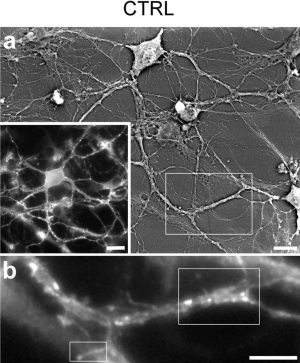Overview
- Peptide QPSQDELKDNTTVFTR(C), corresponding to amino acid residues 28-43 of rat GABRA1 (Accession P62813). Extracellular, N-terminus.
- Rat brain lysates (1:400-1:1000).
 Western blot analysis of rat brain lysates:1. Anti-GABA(A) α1 Receptor (extracellular) Antibody (#AGA-001), (1:1000).
Western blot analysis of rat brain lysates:1. Anti-GABA(A) α1 Receptor (extracellular) Antibody (#AGA-001), (1:1000).
2. Anti-GABA (A) α1 Receptor (extracellular) Antibody, preincubated with GABA(A) α1 Receptor (extracellular) Blocking Peptide (#BLP-GA001).
- Mouse and rat hippocampus.
- Rat adrenal medullary cells (1:100) (Matsuoka, H. et al. (2008) J. Physiol. 586, 4825.).
- Rat PC12 cells (1:100).
- Rat living hippocampal neurons (1:400) (Pribiag, H. and Stellwagen, D. (2013) J. Neurosci. 33, 15879.).
GABA (γ-aminobutyric acid) is the major inhibitory neurotransmitter in the brain. Its production, release, reuptake, and metabolism all occur in the nervous system.1
The GABA transmitter interacts with two major types of receptors: ionotropic GABAA receptors (GABAAR) and metabotropic receptors (GABABR). GABAARs belong to the ligand-gated ion channel superfamily.2 GABA inhibits the activity of signal-receiving neurons by interacting with the GABAA receptor on these cells.3 Binding of GABA to its GABAA receptor results in conformational changes that open a Cl- channel, producing an increase in membrane conductance that results in inhibition of neural activity.2
GABAARs are heteropentamers, in which all five subunits contribute to pore formation. To date, eight subunit isoforms have been cloned:α, β, γ, δ, ε, π, θ, and ρ.1 Six α subunit isoforms have been found to exist in mammals (α1-α6). In most cases, native GABAA receptors consists of 2α, 2β, and 1δ subunits. The α subunit is the most common and is expressed ubiquitously. It determines the affinities of GABAARs for allosteric ligands.
Each subtype has a unique regional expression in the brain, and individual neurons often express multiple subtypes.4 The α1 subunit is highly expressed in adulthood while the α2 subunit is highly expressed very early in rat brain development. Failure to complete the normal transition between the α-subunits that are highly expressed in early development (α2, α3, and α5) and those expressed in adulthood (α1) is suggested to play a major role in the development of temporal lobe epilepsy.5
Application key:
Species reactivity key:

High resolution immuno-scanning electron microscopy (HRSEM) of GABA(A) α1 Receptor in mouse hippocampal neurons.A. BSE (backscattered electron) analysis on mouse primary hippocampal neuron cultures labeled with Anti-GABA(A) α1 Receptor (extracellular) Antibody (#AGA-001) followed by FluoroNanogoldTM Fab secondary antibody reveals the presence of GABRA1 gold clusters of variable size (due to gold-enhancement reaction) on both soma and neurites. B. At higher magnification, gold clusters are observed on the plasma membrane in close proximity to neurite processes covering the neuron cell body. Gold clusters are also detected at contact regions between processes (synaptic contacts).Adapted from Orlando, M. et al. (2017) Sci. Rep. 7, 13768. with permission of NATURE SPRINGER.
